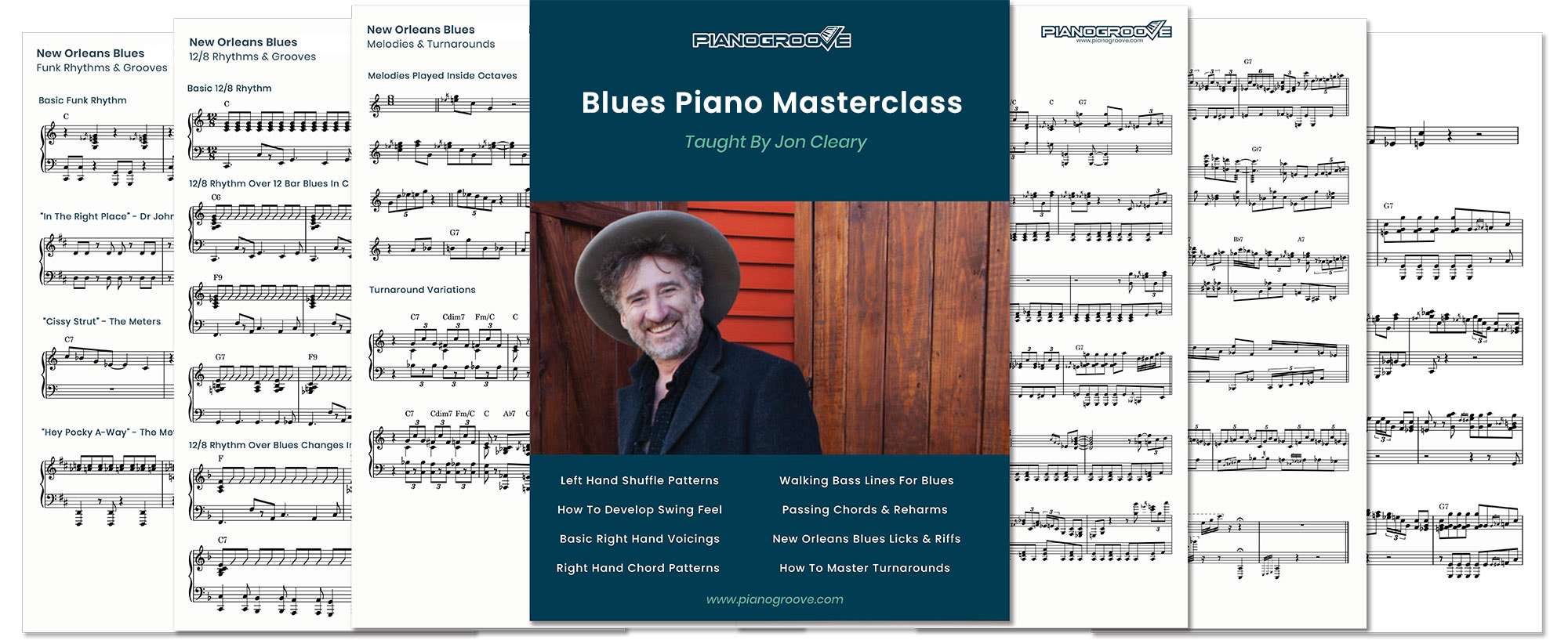Course Lessons
1. The Basic Elements Of The Blues
- 1. 1How To Play A Blues Shuffle13:47
- 1. 2Basic Blues Voicings & Patterns08:37
2. Blues Licks & Walking Bass Lines
- 2. 1Simple Blues Licks & Phrases09:44
- 2. 2Walking Bass Lines & Octaves09:23
3. Chord Substitutions & Turnarounds
- 3. 112 Bar Blues Passing Chords10:06
- 3. 2New Orleans Style Turnarounds04:54
- 3. 3Full 12 Bar Blues Breakdown04:03
4. The 8 Bar Blues Form
- 4. 18 Bar Blues For Beginners08:13
- 4. 28 Bar Blues Chord Substitutions09:16
- 4. 38 Bar Blues Reharmonisations07:51
5. New Orleans Style Blues
- 5. 1Beefing Up The Bottom End08:59
- 5. 2Funky 8 Bar Blues: The Left Hand07:21
- 5. 38 Bar Blues: Maximum Funk08:52
Course Info
Unlock This CourseLearn to play the 12 bar blues with Grammy winner and veteran bluesman Jon Cleary. We explore shuffle patterns, walking bass lines, licks, passing chords, and turnarounds.
The Blues Masterclass Course w/ Jon Cleary

Simple Blues vs. Sophisticated Blues
When playing the blues, simplicity can be a virtue – the blues doesn’t have to be complicated and there is nothing wrong with being crude. New Orleans blues piano has evolved to a high degree of sophistication and nuance but it is useful to have a handle on both ends of the spectrum and be able to play simply as well as complicated. This course starts at the beginning and teaches the core skills needed to build strong foundations when playing the blues.
The 12 Bar Form & Left Hand Shuffle Patterns
The 12 bar blues tell a kind of story, one that takes you off on a journey and then brings you back home. This 12 bar form consists of three chords, the 1, 4 and 5.
The blues shuffle pattern that underpins this form is simple but it is essential to make the music swing. Spend enough time to practice and master these shuffle patterns as they are the engine that drives the music forward. The left hand is the most important part when playing blues piano.
Basic Blues Voicings & Right Hand Patterns
Once we have established our bass lines we can move onto our right hand chording. Jon talks us through the basics of the blues chord voicings and shows us some variations available for the 1, 4 and 5 chords.
We first start with basic triads shapes and then add 7th chords and some jazzy chord extensions such as 9ths and 13ths.
Blues Piano Riffs For The Right Hand
Next we take a look at a few right hand variations and some useful 12 bar blues licks that can be used over all three chords in the blues progression. The notes of this lick are based on the pentatonic scale but we use some passing notes to give it a more interesting bluesy flavour.
We can also add an entire chord to the final note of the phrase which creates a thicker and meatier sound which is characteristic of the New Orleans blues.
Walking Bass Patterns For The Blues
So far we’ve mainly been playing a simple shuffle-style left hand pattern which uses the root, fifth and sixth. However, there are lots of other options available for the left hand. One of these is a 12 bar walking bass patterns where we play octaves in the left hand.
12 Bar Blues Passing Chords
In this lesson Jon shows us some 12 bar blues passing chords and chord substitutions, outlining ways to add some elements of surprise into our blues playing.
In the lessons up to this point we have been using the simplest form of the 12 bar blues. In this form there are three essential chords – the 1, 4 and 5 – but as we turn up the level of sophistication we can start adding more chords to this basic frame. As we do this we get closer to a New Orleans-style blues.
New Orleans Style Turnarounds
The turnaround in its most basic form consists of four chords, beginning and ending with C. It should sound familiar, we often hear guitarists using it to start a song.
The New Orleans style turnaround is often embellished with trills in both the left and right hand. These kinds of sounds were introduced by early blues piano players and they act in a way like a drumroll.
Learn to play the 8 bar blues with Grammy winner and veteran bluesman Jon Cleary. We explore the 8 bar blues form, reharmonisations, bass lines, and embellishments.
8 Bar Blues For Beginners
If you are new to the 8 bar blues, spend some time to fully absorb the basic chord changes and form presented in this lesson. It’s important to have a solid understanding of the basics before we move onto the chord substitutions and reharmonisations presented in the next lessons.
Substituting Chords In The 8 Bar Blues
The 8 bar blues is a very flexible harmonic form and there are a lot of options for chord substitutions, from simple to complex. In its most basic form, the 8 bar blues uses 1, 4 and 5 chords.
Altering The Harmony
Chord alterations are used to dress up the the voicings so that we create a melody that moves through the chords. Chord alterations can be used to great effect over dominant chords to add additional colour and tension. To take it one step further we explore arpeggiating the chords and adding passing notes which move between chords.
Beefing Up The Bottom End
The left hand’s role is primarily stating the root of the chord and often this simple choice is the best. It works perfectly well and leaves the listener in no doubt about what’s going on. However, you don’t have to be restricted by this and it’s important to experiment with other options.
Left & Right Hand Interplay
For any music that is leaning towards a funk-based style, the gaps and the space that we leave are very important. Rhythmic considerations are very important for students exploring the New Orleans piano style where the left hand and right hand have to work together.
Straight vs. Syncopated
Throughout the course, Jon demonstrates the different approaches to playing the 8 bar blues. One approach is to play with a straight triplet vibe similar to the styles of Fats Domino and Smiley Lewis. The other end of the syncopation level is the New Orleans 8 Bar Blues such as "Tipitina".




